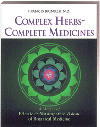History of Eclectic Medical Publications
Publisher: Edward Alstat, R.Ph., N.D.
Production: Nancy Stodart
Cover Art: Richard Stodart
The Eclectic Era of American Botanical Medicine
Through most of the l800's and the first half of the 20th Century, many Americans employed a practice of medicine known as Eclectic. Together with traditional medicines the Eclectic physicians developed and utilized botanical remedies that were native to America. They emphasized certain guidelines in choosing their medicines. Their motto, "sustain the vital forces," described support to balance function to aid the return to health. Second, they selected remedies that were specifically indicated for each individual patient. Medical schools, private clinical practices and investigations, and botanical pharmacies were innovative and developed on empirical and scientific standards. Documentation of this work was published in their own medical journals, materia medica, and botanical dispensatories. By 1940, this golden era of botanical medicine had declined, due to pressures from costs for private academic facilities, medical politics, and synthetic pharmaceuticals, to the point that the pre-eminent school, Eclectic Medical College of Cincinnati, had graduated its last class and then closed its doors forever.
From that time until about 1970, little research was conducted on botanical medicine in the United States, aside from isolation of phytochemicals for drug development. In Europe, work on echinacea fresh extracts and standardized extracts of saw palmetto, black cohosh, and other American plants was underway, principally in Germany. The clinical botanical text of note during this period was Rudolph Weiss's Herbal Medicine, published in German in 1960 and translated to English in 1988, serving as a primer for doctors without formal herbal training. In 1983 the Eclectic Institute began in Portland, Oregon, renewing interest in Eclectic preparations and developing modern innovative methods and products. Later in Sandy, Oregon, it continued to expand independent botanical research under the direction of its owner, Dr. Ed Alstat. Dr. Alstat was a graduate of the St. Louis College of Pharmacy and the National College of Naturopathic Medicine where he managed the clinic dispensary before starting Eclectic Institute.
Preserving the Past and Serving the Future of Botanical Research
Eclectic Medical Publications was also originated by Dr. Alstat in Portland in 1983 to make available the great botanical reference texts of the Eclectics, beginning with such works as King's American Dispensatory, The Eclectic Materia Medica, Pharmacology and Therapeutics, and American Materia Medica, Therapeutics and Pharmacognosy, and including the earlier distinctive classics, Specific Diagnosis and The Physio-Medical Dispensatory. Research into the Eclectic journals later led Dr. Alstat and Dr. Francis Brinker to compile clinical material on botanicals that had long lay neglected as The Eclectic Medical Journal Reprints, Vol. 1 & 2. These historical Materia Medicas, EMJ reprints, and other texts are still available from EMP. (See Historical ? Research.)
In 1989, EMP initiated its own original titles. Naturopath physicians Ed Alstat, Francis Brinker, and Wade Boyle along with others began to present modern literature research to complement and update the historical data. Their first effort, The Eclectic Dispensatory Of Botanical Therapeutics, Vol. 1, resulted in an expansive 3-ring binder with five sections (Historical, Clinical, Pharmacology, Materia Medica, and Monographs). In 1995, Dr. Brinker wrote The Eclectic Dispensatory Of Botanical Therapeutics, Vol. 2, another 3-ring binder in 5 sections. This volume includes three full length books, five published articles and a condensed Botanical Medicine Research Summary section highlighting human studies in bold type. One of these books, Formulas For Healthful Living, a major primer on the healing principles and botanical formulas of naturopathic medicine, was also published separately by EMP as its first quality paperback in 1995. The second edition, released in l998 continues to sell well to those interested in supporting the body's healing processes.
In 1997 Dr. Brinker completed the immensely popular Herb Contraindications and Drug Interactions. A quality paperback now in its fourth expanded edition, this book is unique in the organization of research information on the interactions between plant medicines and pharmaceuticals, as the only resource of its kind that categorizes the type of referenced research study next to the body text. Hence, readers know as they read what kind of study resulted in the reported findings, whether in ¬humans, in animals, or in vitro. In 1999 EMP released Interactions Between Drugs & Natural Medicines by Chris D. Meletis, N.D. and Thad Jacobs, N.D. Developed from clinical needs, this book is organized for quick access to information by category group and individual name. A second edition was published in 2005.
The Toxicology of Botanical Medicines, Third Edition, by Dr. Brinker was published as a quality paperback in 2000. An ongoing work for 15 years, this handbook provides a concise compilation of past clinical and up-to-date research information on the toxic effects of plants and their medicinal extracts, along with emergency treatments to consider prior to exhaustive evaluation and/or hospital admission. This book is a response to uneducated consumers misusing wild plants or herbal extracts, as botanicals are gaining popularity in stores and online.
The need for recognizing distinctions between different preparations of the same herb led to the publication in 2004 of another book by Dr. Brinker, Complex Herbs ? Complete Medicines. By discussing the various forms of preparations used since the days of the Eclectics and the different types of phytochemicals present and extracted with specific solvents, this book prepares the reader to make intelligent choices that meet their particular needs. The text describes past, present, and possible future trends and the advantages of whole herbs and native extracts in managing multifactoral conditions.
With the 2010 publication of the newly titled Herbal Contraindications and Drug Interactions plus Herbal Adjuncts with Medicines, Eclectic Medical Publications brings to the fore Dr. Brinker's research into the limitations and advantages of utilizing botanicals with conventional pharmaceutical medications. This advanced development of organized research will help doctors and patients alike to realize and understand the potential benefit or harm that can result from combining conventional medicine with complementary or antagonistic botanicals.
 Menu
Menu
